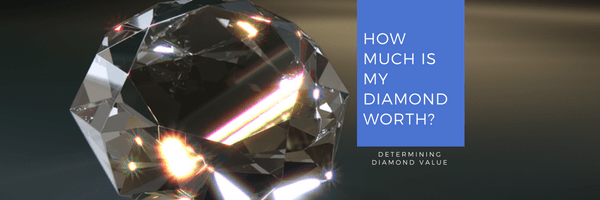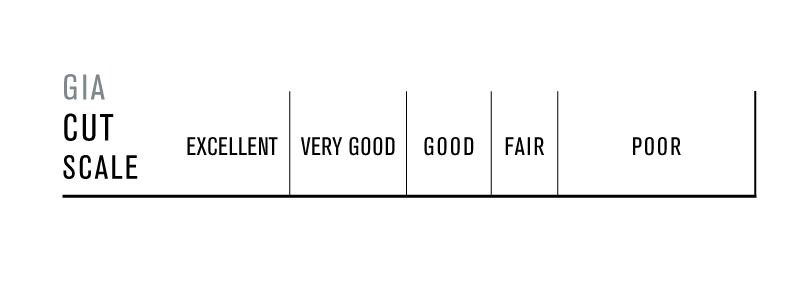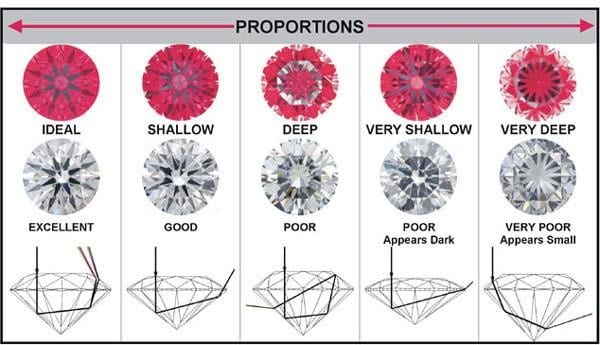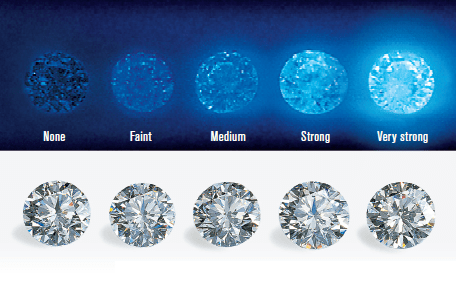What you need to know to determine diamond value.
When it’s time to sell your diamond, knowledge is power. Your first question is going to be: how much is my diamond worth? Taking some time to educate yourself about the diamond valuing process will not only help you get the best price possible, but also protect you from predatory buyers.

Unfortunately, there are diamond and diamond jewelry buyers out there who are more worried about themselves, than helping you through your diamond sales process. If you need the money, they can sense it like a shark smells blood in the water from the moment you speak, and they want to take full advantage. They want to pay you as little as they can so they can hit a homerun at your expense.
My advice — trust no one. Arm yourself with the knowledge you need to negotiate with any potential buyer. Buyers sense seller’s confidence as well, and believe me, it is the first step to maximizing what you will receive for your diamond.
Over the past 20 years in the diamonds business, I’ve noticed the most educated sellers have a set of traits in common. I’ll outline those here in this diamonds selling guide to help you arm yourself as you look to sell your diamonds and diamonds jewelry.
Be clear on your expectations.
Before you even begin the diamond selling process. Reflect on your current situation.
- Why are you selling?
- How quickly do you need the funds that selling your diamond will generate?
- How much of the decision on your asking price is based on your personal connection to the diamond?
For the seller, it is often a scary and emotional process. For the buyer, it’s simply a business transaction. This doesn’t mean that the buyer cannot have compassion and genuine concern for you and your particular situation. If you are not entering the transaction with the same mindset, you are already starting with a disadvantage.
Avoid false confidence
Many times, sellers will walk into the transaction with false confidence. They have the right idea. They want to present themselves as knowledgeable and in no hurry to sell. They want the buyer to know from the initial interaction that they are not one that can be taken advantage of. But this confidence is driven by fear, not knowledge. It is the fear of selling too cheap. The fear of walking out and leaving the buyer with a giant grin on their face as if they just hit their number on the roulette table. Do those buyers exist? Of course, and you do have to be weary of them. But true knowledge will allow you to sniff them out and not the other way around.
The good news is that not all buyers are that way. Many are fair and honest and want to help you as much as possible while still making a fair and reasonable profit. Uneducated, undeserved confidence from the seller is the fastest way to ruin what could potentially be your best opportunity to maximize your diamond’s value.
Nothing will turn an honest buyer away faster than a client who rejects an offer with no rhyme or reason and no information about what they would like to receive, just… more. Buyers are not going to negotiate against themselves, especially when it is clear that there may be no end in sight.
Educate yourself. You must understand what you have and what a buyer in that market is willing to pay. If you do, you can have a price in mind that you feel is fair based on the knowledge that you have gained. And if you find it, take it.
Here are some steps to start learning what you have and what it’s worth so you can gain the confidence you need to sell your diamond as quickly as possible, and for the highest possible value.
Understanding diamond quality and value
Many sellers are aware of the 4 Cs of diamond grading. This standard of classifying a diamond’s quality for its Cut, Color, Clarity, and Carat Weight was developed by the GIA (Gemological Institute of America) in the mid-twentieth century. This scale was developed to create a universal language in which diamond quality could be communicated. Each of these Cs plays an equally important role in the diamond’s value, and having an understanding of them will help you determine and negotiate the best price possible. So let’s take a look at each of the 4 Cs.
Diamond Cut
A diamond’s “Cut” often refers to its shape. Diamonds can be cut in many different shapes as you can see from the chart below. Remember, these correct names of each diamond shape are part of the universal diamond language. Speaking that language correctly shows a buyer that you are not just an average seller. Calling your diamond a “Princess Cut” instead of square or “Marquise” instead of football shape, tells a buyer that you are familiar and knowledgeable about what you have.

When it comes to the relationship between shape and value, fashion trends play a huge role. While round brilliant cut diamonds — and their ability to be cut with such precision as to maximize a diamond’s brilliance above all others — have stood the test of time, all other shapes, referred to as “Fancy Shapes”, are subject to these market fluctuations.
One shape can be extremely hot on the retail market while another is rarely requested. This market demand can cause prices for fancy shape diamonds to rise or fall in dramatic fashion. When discussing shape with your buyer, remember, it’s not what you like, it’s what the market wants. That is the buyers’ only concern. So do your research and see what is trending at the moment.
While Cut does refer to a diamond’s shape, there is a much more complicated part of a diamond’s cut, and it plays an enormous role in a diamond’s value — no matter the shape. One major difference between diamond shapes is their Facet structure. The Facets are each of the flat areas that help in giving a diamond its Brightness, Fire, and Scintillation — the three components that allow a diamond to sparkle.
The relationship that each of these facets have to the other, their size, shape, and angle, are an extremely precise science that when done in an optimal way, make the difference between a beautiful and lively diamond, and one that appears dull and lifeless.
Unless you are an engineer, understanding the optimal size and angle of each of a diamond’s facet can be daunting to say the least. In fact, I would venture to say that the majority of diamond sales people in most jewelry stores could not accurately tell you the standards required by GIA for a diamond to receive one cut grade over another. Luckily, GIA has simplified this understanding of cut by breaking them into simpler terms shown in the chart below.

A diamond’s overall cut grade is the only of the 4 Cs that human hands play a role in determining. It is also arguably the most vital to a diamond’s beauty. A well cut diamond will create such brilliance that it can help to mask lower color grades and even cause inclusions to become more difficult to recognize with the naked eye. The demand for diamonds with Excellent and Very Good cut grades has risen substantially over the past decade.
If your diamond has one of these high cut grade levels, be sure the buyers’ price reflects this high demand. If your diamond’s cut is graded as Good or below, expect the offer to reflect that as well.
Color

A diamond’s color actually refers to the absence of color that a diamond has. These differences can be so slight that diamonds are graded for color upside down to remove the effects of the diamonds brilliance, placed against a pure white background, with optimal lighting, and compared to a master set of diamonds that have already had their color grade established. Most diamonds have some level of color. In fact, the majority of diamonds used in jewelry is in the near colorless range G-J. The bottom line is, the higher a diamond’s color, the rarer and therefore more valuable it becomes.
Clarity
Clarity refers to a diamond’s internal and external characteristics or inclusions. A diamond’s final clarity grade is determined by evaluating the size, nature (type), number, and location of each of these inclusions while using 10x magnification.

Just as with color, the higher the diamond rates on the clarity scale, the rarer and therefore more valuable it becomes. The most difficult part of clarity is that even within a particular clarity grade, one diamond may be valued higher than another. This is due to the diamond’s marketability.
A diamond buyer wants to resell your diamond and the more desirable it is to a buyer, the faster he can sell it and the more he will be able to command.
For Example, one diamond with a GIA clarity grade of SI2 has a callable, or grade setting inclusion, that is a white or even translucent inclusion located near the outer edge of the diamond. When mounted in a setting, this inclusion can be mostly if not completely covered by a prong, concealing it and giving the diamond the visual appearance of a much higher clarity grade.
The next diamond with a grade of SI2 and all other factors being equal has a large black inclusion that is located in the very center or table of the diamond. Its type and location within the diamond makes it easily seen without magnification by even an untrained eye.
If you were purchasing one of these diamonds, which would you choose?
The answer is clear and therefore while the two diamonds seem similar on paper, they cannot be valued the same.
Using Cut, Clarity, and Color To Determine Diamond Worth
Take some time to study your diamond visually prior to taking it to the buyer. If possible, visit a local jeweler and ask to use their Loupe and help you to locate your inclusions. If they are small, located toward the edges of the diamond, white or translucent, able to be covered or mostly covered by a prong when mounted, use these facts to state your reason for a higher value with your diamond buyer. If they are not the optimal type and location, study the diamond without magnification. Diamond buyers ultimately want the diamond to be “Eye Clean”. You can describe the diamond to the buyer as completely eye clean or use a percentage such as 90% or 95% eye clean.
The point is to try and recognize if your inclusions would affect your opinion of value if you were the buyer. If you answer is no, then push for a higher value. Be fair and the buyer will be fair with you.
Carat Weight
A diamond’s carat weight is just that, a measurement of weight. A 1.00ct diamond is 100 points; just there are 100 cents in a dollar. It would seem fairly obvious that the more carat weight a diamond has, the higher its value. While this is most often true, there are other important factors to consider.
First, when discussing carat weight, you must consider its correlation to the cut grade. This is because where the carat weight is in the diamond plays a major role in its appearance. See the chart below.

As you can see, the diamond’s proportions can have a dramatic visual effect. A buyer of a 1.00ct round brilliant cut diamond wants that diamond to look like a 1.00ct, which has an ideal diameter of 6.4mm. If your diamond is cut too deep, the weight may stay at a 1.00ct, but that weight is in the bottom of the stone, not only affecting its brilliance, but narrowing the diameter and giving it the visual appearance of a much smaller diamond. Again, put yourself in the retail buyer’s shoes, which would you choose?
The second important factor in carat weight is understanding the diamond price list. This is a chart produced by an independent company and widely accepted throughout the industry as the baseline for diamond pricing. It is set in incremental weights and priced as per carat. Meaning the dollar value multiplied by the exact carat weight determines the net value. (Ex. $1000 p/c x 1.50ct = $1500) Within this list there can be substantial price changes at incremental points. 0.70ct-0.89ct, 0.90ct-0.99ct, 1.00ct-1.49ct, 1.50ct-1.99ct, and so on.
If you have a 1.00ct round brilliant cut diamond that should measure 6.4mm but instead only has a diameter of 5.8mm, it visually appears as a 0.75ct diamond and it is reasonable that the buyer would value it as such, because when his buyer is considering a purchase, they certainly will.
Additional Quality Factors
Beyond the 4 Cs, there are quality factors that can play a large role in your diamond’s value. A diamond’s Polish and Symmetry are also indicated on GIA diamond grading reports and use the same scale as the cut grade, being Excellent, Very Good, Good, Fair, and Poor.
Many buyers have become more educated in diamond grading with the large amounts of information that the internet provides. Because of this, Diamonds with Cut, Polish, and Symmetry grades of Excellent, referred to as Ex, x3 or Triple Ex, or at a minimum of Very Good (VG) are much more sought after on the retail market. While in truth, a retail buyer may see absolutely no difference, the demand for these stones has raised their market value.
The final factor outside of the 4 Cs is the presence of Fluorescence within a diamond. Fluorescence is trace amounts of elements such as boron, nitrogen, or aluminum that are trapped within a diamond during formation. When exposed to a UV light, they cause a diamond to glow, typically with a blue color, in varying levels of intensity.
GIA grades the presence of Fluorescence as follows

While strong levels of fluorescence can negatively impact a diamond by giving it a milky or hazy appearance, it is a factor that is far too often misunderstood by the retail buying public. In fact, in lower color diamonds, fluorescence can often have a positive effect, causing them to appear whiter than their stated color grade while having no negative impact at all. While the industry as a whole has been working diligently to educate the buying public on the realities and misconceptions of fluorescence, until they are able, fluorescence still has a negative impact on a diamond’s value. Not because it is affecting the diamond’s beauty, but rather, its marketability.

